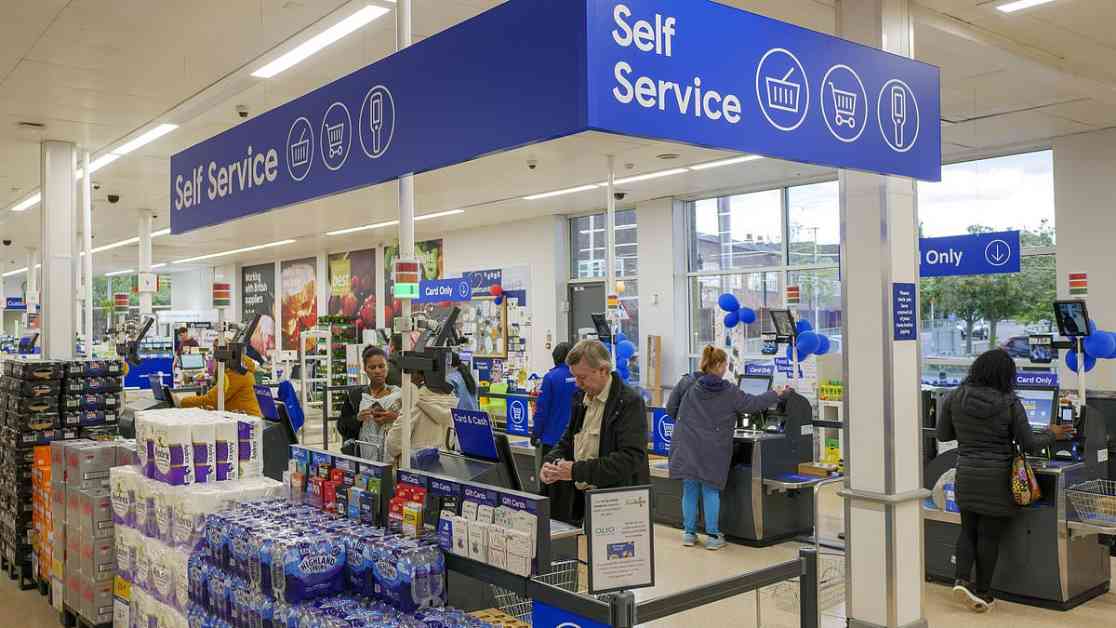Shoplifting Behavior Unveiled at Self-Checkout Counters
A recent survey conducted by The Grocer magazine has shed light on a concerning trend among British shoppers. More than a third of respondents confessed to using self-service checkouts as an opportunity to pilfer from stores. This revelation has sparked discussions about the rise of ‘middle-class shoplifters’ who are contributing to the escalating issue of theft in retail establishments across the UK.
The survey, which polled 1,000 British shoppers, revealed that 37 percent of customers intentionally neglected to scan items at self-service checkouts, with men and individuals under the age of 35 being the most common culprits. Additionally, 32.5 percent of respondents admitted to inaccurately weighing loose items, while 38 percent confessed to employing the ‘banana trick’ – a method used to pass off pricey items as cheaper ones by scanning them as produce.
Criminology experts have weighed in on this phenomenon, noting that the advent of self-service machines has given rise to a new category of shoplifters who exploit these systems in ways they wouldn’t have considered previously. The convenience and anonymity provided by self-checkout counters have emboldened individuals to engage in theft during transactions, posing challenges for retailers in curbing such behavior.
The British Retail Consortium has expressed concerns over the shoplifting epidemic, deeming it a crisis that is rapidly spiraling out of control. Data released by the consortium indicated that an alarming 20 million shoplifting incidents were reported in the 2023/24 financial year, averaging 55,000 cases per day and resulting in a staggering £2.2 billion in losses for retailers. Despite investing £1.8 billion in prevention measures like CCTV and anti-theft devices, retailers continue to grapple with the financial repercussions of theft.
Helen Dickinson, chief executive of the BRC, highlighted the growing boldness and aggression of criminals, underscoring the challenges faced by retailers who often lack confidence in law enforcement’s ability to respond swiftly to incidents. The prevalence of theft in retail settings has become a pressing issue that demands urgent attention and collaborative solutions from stakeholders across the industry.
Unveiling the Psychology of Self-Scan Shoplifting
Matt Hopkins, an associate professor in criminology at the University of Leicester, delves into the psychological underpinnings of self-scan shoplifting, emphasizing the unintended consequences of transitioning to self-checkout systems. Hopkins notes that the shift to self-service machines has inadvertently created opportunities for individuals who may not have previously considered engaging in theft. The allure of circumventing traditional checkout processes and the perceived anonymity of self-service counters have emboldened some shoppers to exploit these systems for personal gain.
Archie Norman, chairman of Marks & Spencer, has echoed these sentiments, attributing the rise in shoplifting incidents to the accessibility and perceived ease of stealing through self-checkout counters. Norman’s observations underscore the complex interplay between consumer behavior, convenience, and ethical considerations when it comes to retail transactions. The normalization of minor thefts, justified by frustrations with self-service technology, poses a significant challenge for retailers seeking to maintain integrity and prevent losses.
Retailers’ Response and the Evolution of Self-Checkout Technology
In response to the escalating concerns surrounding self-scan shoplifting, retailers have implemented various strategies to address the issue. While self-service tills were initially introduced to streamline operations and reduce costs, the unintended consequences of increased theft have prompted retailers to reassess their approach to checkout systems.
Major supermarket chains like M&S have trialed innovative self-checkout technologies, such as RFID chips, to enhance security and deter theft at self-service counters. By leveraging advanced technology to track and authenticate purchases, retailers aim to strike a balance between convenience and loss prevention in an evolving retail landscape.
Despite the push for automation and self-service options, some retailers have encountered pushback from consumers who prefer the human touch of traditional manned tills. The ongoing debate between efficiency, security, and customer experience underscores the nuanced challenges facing retailers in combating shoplifting while maintaining a positive shopping environment for patrons.
In conclusion, the prevalence of self-scan shoplifting underscores the complex interplay between consumer behavior, technology, and loss prevention strategies in the retail sector. As retailers navigate the evolving landscape of self-checkout systems and security measures, addressing the root causes of theft and fostering a culture of integrity and accountability remain paramount in safeguarding the future of retail operations.









